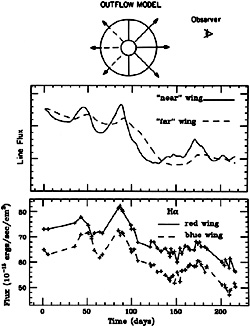


9.5. Cross-correlation Tests
The correlated line and continuum variability provides an additional, powerful test on several of the assumptions made here. Consider a radially moving system of clouds. The emission line light curves of the blue and the red wings of the lines represent the emission from the near and the far hemispheres. These are very different, because of the different distance to the observer. The response of the near hemisphere is almost immediate, with sharp features, while the the far hemisphere is an average over a longer time, with smooth, features.

|
Figure 27. Top: A schematic representation
of a spherical outflowing system of clouds. Middle:
Theoretical blue and red wing light curves obtained by assuming
constant emission per unit
covering factor, and the continuum light curve of NGC 4151
(Fig. 17). Bottom: Observed light
curves for the blue and red wings of
H |
The situation is illustrated in Fig. 27. for
the case of NGC 4151 discussed
in chapter 8. The top part of the diagram
shows theoretical blue and red wing
light curves, given tile variable continuum of this source
(Fig. 17). This should
be compared with the measured light curves of the blue and red halves of the
H line, shown in
the lower panel. The difference between the model and the
observations is very large indeed: The measured red and blue wing light
curves
are identical, within the errors (and their cross-correlation gives a
zero time lag) and do not resemble the theoretical curves. This suggests
that a radial gas motion can be ruled out at a high confidence level, in
this source.
line, shown in
the lower panel. The difference between the model and the
observations is very large indeed: The measured red and blue wing light
curves
are identical, within the errors (and their cross-correlation gives a
zero time lag) and do not resemble the theoretical curves. This suggests
that a radial gas motion can be ruled out at a high confidence level, in
this source.
Variable line profiles are important since they provide a way for mapping out the velocity field in the BLR. In principle, the transfer function should be constructed for each velocity, and a full 6-dimensional phase-space analysis should be performed. Obtaining profile information at each phase of activity is even more difficult than following the light curve behavior, and at time of writing no such analysis has been carried out.